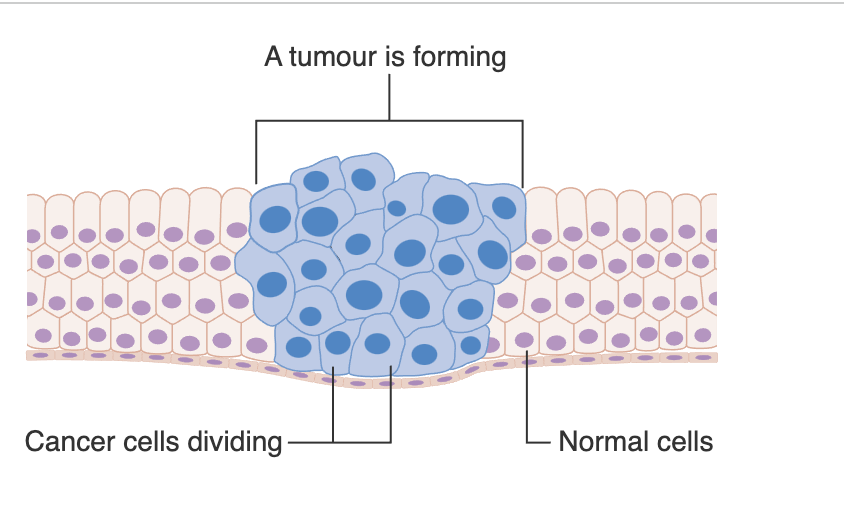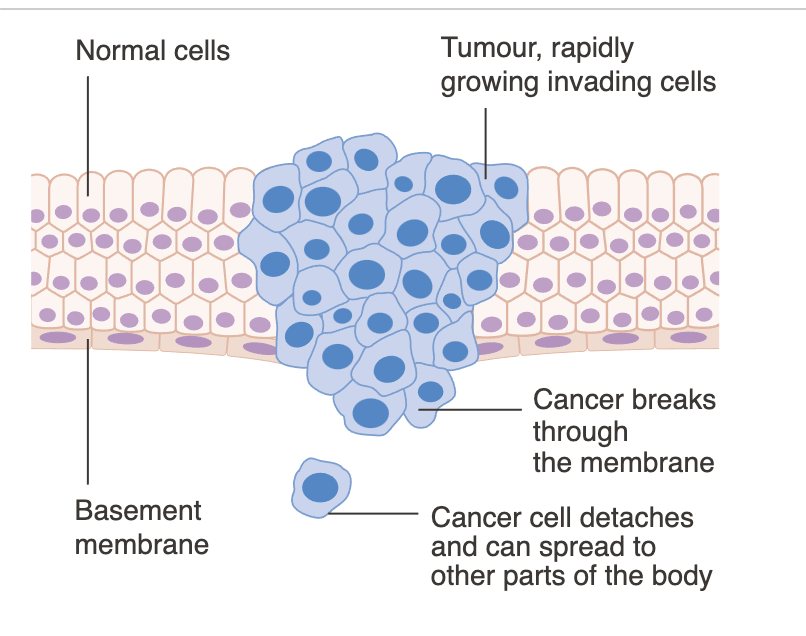13.1: Understanding Cancer
- Page ID
- 86882
\( \newcommand{\vecs}[1]{\overset { \scriptstyle \rightharpoonup} {\mathbf{#1}} } \)
\( \newcommand{\vecd}[1]{\overset{-\!-\!\rightharpoonup}{\vphantom{a}\smash {#1}}} \)
\( \newcommand{\dsum}{\displaystyle\sum\limits} \)
\( \newcommand{\dint}{\displaystyle\int\limits} \)
\( \newcommand{\dlim}{\displaystyle\lim\limits} \)
\( \newcommand{\id}{\mathrm{id}}\) \( \newcommand{\Span}{\mathrm{span}}\)
( \newcommand{\kernel}{\mathrm{null}\,}\) \( \newcommand{\range}{\mathrm{range}\,}\)
\( \newcommand{\RealPart}{\mathrm{Re}}\) \( \newcommand{\ImaginaryPart}{\mathrm{Im}}\)
\( \newcommand{\Argument}{\mathrm{Arg}}\) \( \newcommand{\norm}[1]{\| #1 \|}\)
\( \newcommand{\inner}[2]{\langle #1, #2 \rangle}\)
\( \newcommand{\Span}{\mathrm{span}}\)
\( \newcommand{\id}{\mathrm{id}}\)
\( \newcommand{\Span}{\mathrm{span}}\)
\( \newcommand{\kernel}{\mathrm{null}\,}\)
\( \newcommand{\range}{\mathrm{range}\,}\)
\( \newcommand{\RealPart}{\mathrm{Re}}\)
\( \newcommand{\ImaginaryPart}{\mathrm{Im}}\)
\( \newcommand{\Argument}{\mathrm{Arg}}\)
\( \newcommand{\norm}[1]{\| #1 \|}\)
\( \newcommand{\inner}[2]{\langle #1, #2 \rangle}\)
\( \newcommand{\Span}{\mathrm{span}}\) \( \newcommand{\AA}{\unicode[.8,0]{x212B}}\)
\( \newcommand{\vectorA}[1]{\vec{#1}} % arrow\)
\( \newcommand{\vectorAt}[1]{\vec{\text{#1}}} % arrow\)
\( \newcommand{\vectorB}[1]{\overset { \scriptstyle \rightharpoonup} {\mathbf{#1}} } \)
\( \newcommand{\vectorC}[1]{\textbf{#1}} \)
\( \newcommand{\vectorD}[1]{\overrightarrow{#1}} \)
\( \newcommand{\vectorDt}[1]{\overrightarrow{\text{#1}}} \)
\( \newcommand{\vectE}[1]{\overset{-\!-\!\rightharpoonup}{\vphantom{a}\smash{\mathbf {#1}}}} \)
\( \newcommand{\vecs}[1]{\overset { \scriptstyle \rightharpoonup} {\mathbf{#1}} } \)
\( \newcommand{\vecd}[1]{\overset{-\!-\!\rightharpoonup}{\vphantom{a}\smash {#1}}} \)
\(\newcommand{\avec}{\mathbf a}\) \(\newcommand{\bvec}{\mathbf b}\) \(\newcommand{\cvec}{\mathbf c}\) \(\newcommand{\dvec}{\mathbf d}\) \(\newcommand{\dtil}{\widetilde{\mathbf d}}\) \(\newcommand{\evec}{\mathbf e}\) \(\newcommand{\fvec}{\mathbf f}\) \(\newcommand{\nvec}{\mathbf n}\) \(\newcommand{\pvec}{\mathbf p}\) \(\newcommand{\qvec}{\mathbf q}\) \(\newcommand{\svec}{\mathbf s}\) \(\newcommand{\tvec}{\mathbf t}\) \(\newcommand{\uvec}{\mathbf u}\) \(\newcommand{\vvec}{\mathbf v}\) \(\newcommand{\wvec}{\mathbf w}\) \(\newcommand{\xvec}{\mathbf x}\) \(\newcommand{\yvec}{\mathbf y}\) \(\newcommand{\zvec}{\mathbf z}\) \(\newcommand{\rvec}{\mathbf r}\) \(\newcommand{\mvec}{\mathbf m}\) \(\newcommand{\zerovec}{\mathbf 0}\) \(\newcommand{\onevec}{\mathbf 1}\) \(\newcommand{\real}{\mathbb R}\) \(\newcommand{\twovec}[2]{\left[\begin{array}{r}#1 \\ #2 \end{array}\right]}\) \(\newcommand{\ctwovec}[2]{\left[\begin{array}{c}#1 \\ #2 \end{array}\right]}\) \(\newcommand{\threevec}[3]{\left[\begin{array}{r}#1 \\ #2 \\ #3 \end{array}\right]}\) \(\newcommand{\cthreevec}[3]{\left[\begin{array}{c}#1 \\ #2 \\ #3 \end{array}\right]}\) \(\newcommand{\fourvec}[4]{\left[\begin{array}{r}#1 \\ #2 \\ #3 \\ #4 \end{array}\right]}\) \(\newcommand{\cfourvec}[4]{\left[\begin{array}{c}#1 \\ #2 \\ #3 \\ #4 \end{array}\right]}\) \(\newcommand{\fivevec}[5]{\left[\begin{array}{r}#1 \\ #2 \\ #3 \\ #4 \\ #5 \\ \end{array}\right]}\) \(\newcommand{\cfivevec}[5]{\left[\begin{array}{c}#1 \\ #2 \\ #3 \\ #4 \\ #5 \\ \end{array}\right]}\) \(\newcommand{\mattwo}[4]{\left[\begin{array}{rr}#1 \amp #2 \\ #3 \amp #4 \\ \end{array}\right]}\) \(\newcommand{\laspan}[1]{\text{Span}\{#1\}}\) \(\newcommand{\bcal}{\cal B}\) \(\newcommand{\ccal}{\cal C}\) \(\newcommand{\scal}{\cal S}\) \(\newcommand{\wcal}{\cal W}\) \(\newcommand{\ecal}{\cal E}\) \(\newcommand{\coords}[2]{\left\{#1\right\}_{#2}}\) \(\newcommand{\gray}[1]{\color{gray}{#1}}\) \(\newcommand{\lgray}[1]{\color{lightgray}{#1}}\) \(\newcommand{\rank}{\operatorname{rank}}\) \(\newcommand{\row}{\text{Row}}\) \(\newcommand{\col}{\text{Col}}\) \(\renewcommand{\row}{\text{Row}}\) \(\newcommand{\nul}{\text{Nul}}\) \(\newcommand{\var}{\text{Var}}\) \(\newcommand{\corr}{\text{corr}}\) \(\newcommand{\len}[1]{\left|#1\right|}\) \(\newcommand{\bbar}{\overline{\bvec}}\) \(\newcommand{\bhat}{\widehat{\bvec}}\) \(\newcommand{\bperp}{\bvec^\perp}\) \(\newcommand{\xhat}{\widehat{\xvec}}\) \(\newcommand{\vhat}{\widehat{\vvec}}\) \(\newcommand{\uhat}{\widehat{\uvec}}\) \(\newcommand{\what}{\widehat{\wvec}}\) \(\newcommand{\Sighat}{\widehat{\Sigma}}\) \(\newcommand{\lt}{<}\) \(\newcommand{\gt}{>}\) \(\newcommand{\amp}{&}\) \(\definecolor{fillinmathshade}{gray}{0.9}\)Cancer can start almost anywhere in the human body, when just one of the trillions of cells changes and begins to grow uncontrollably and spread to other parts of the body. Normally, human cells grow and multiply (through a process called cell division) to form new cells as the body needs them. When cells grow old or become damaged, they are supposed to die and new cells take their place, however sometimes abnormal or damaged cells grow and multiply when they shouldn’t. These cells typically form tumors, which are lumps of tissue.
Normal Cells versus Cancer Cells
Cells group themselves together to make up the tissues and organs of our bodies and usually we have just the right number of each type of cell. This is because cells produce signals to control how much and how often the cells divide. For example, when the body is growing, such as from childhood to adulthood, the body will signal for more cells as the body tissues grow. Normal healthy cells also like each other, they know which other cells to join up with, and they stick together.
Normal cells:
- control their growth, reproducing when and where it’s needed.
- stick together and remain in their intended location in the body.
- die when they become damaged or too old to maintain homeostasis.
- become specialized with specific functions.
Cancer cells:
- grow in the absence of signals telling them to grow (normal cells only grow when they receive such signals).
- ignore signals that normally tell cells to stop dividing or to die .
- invade into nearby areas and spread to other areas of the body.
- tell blood vessels to grow toward tumors.
- hide from or trick the the immune system. The immune system normally eliminates damaged or abnormal cells. Cancers cells can trick the immune system into helping cancer cells stay alive and grow.
- accumulate multiple changes in their chromosomes, such as duplications and deletions of chromosome parts. Some cancer cells have double the normal number of chromosomes.
- rely on different kinds of nutrients than normal cells. In addition, some cancer cells make energy from nutrients in a different way than most normal cells. This lets cancer cells grow more quickly.


Benign versus Malignant Tumors
When cells grow and divide they may form tumors, which are a lump of tissue. These lumps might be benign or malignant. A benign tumor is not cancerous, a malignant tumor is cancerous. However, not all cancers form tumors, leukemia is a cancer of the blood cells that does not develop tumors, instead, the cancer cells build up in the blood and sometimes the bone marrow.
The big difference between a cancerous (malignant) tumor versus a non-cancerous (benign) tumor is the ability of the tumor to spread to other areas of the body, which is called metastasis. Benign tumors do not spread into, or invade, nearby tissues and are usually left in the body unless it is causing pain or is life threatening, such as benign tumors in the brain. Whereas, cancerous (malignant) tumors spread into, or invade, nearby tissues and can travel to distant places in the body to form new tumors.

Benign tumors:
- usually grow quite slowly
- don’t spread to other parts of the body
- usually have a covering made up of normal cells
Malignant tumors:
- usually grow faster than benign tumors
- spread into surrounding tissues and cause damage
- may spread to other parts of the body in the bloodstream or through the lymph system to form secondary tumors. This is called metastasis
Metastasis
Cancer cells don’t like each other and do not stick together like normal cells. Rather, cancer cells leave their origin and spread to other parts of the body. The development of secondary malignant growths at a distance from a primary site of cancer is known as metastasis. When a cancer has spread to other parts of the body it is determined to be stage IV (4) cancer.
Cancer cells spread through the body in a series of steps:
- Grow into, or invade, nearby normal tissue.
- Move through the walls of nearby lymph nodes or blood vessels.
- Travel through the lymphatic system and bloodstream to other parts of the body.
- Stop in small blood vessels at a distant location, invading the blood vessel walls, and moving into the surrounding tissue.
- Grow in this tissue until a tiny tumor forms.
- Cause new blood vessels to grow, which creates a blood supply that allows the metastatic tumor to continue growing.
Cancer can metastasize to several places in the body, however it will be known by the primary site where the initial cancer cell began. For example, if a person has breast cancer that has spread to the lung, they will be determined to have stage IV breast cancer with lung metastases, not as lung cancer.

| Cancer Type | Main Sites of Metastasis or Secondary Tumors |
|---|---|
| Bladder | Bone, liver, lung |
| Breast | Bone, brain, liver, lung |
| Colon | Liver, lung, peritoneum |
| Kidney | Adrenal gland, bone, brain, liver, lung |
| Lung | Adrenal gland, bone, brain, liver, other lung |
| Melanoma | Bone, brain, liver, lung, skin, muscle |
| Ovary | Liver, lung, peritoneum |
| Pancreas | Liver, lung, peritoneum |
| Prostate | Adrenal gland, bone, liver, lung |
| Rectal | Liver, lung, peritoneum |
| Stomach | Liver, lung, peritoneum |
| Thyroid | Bone, liver, lung |
| Uterus | Bone, liver, lung, peritoneum, vagina |
Cancer Stages
The cancer stage refers to the extent of your cancer, such as how large the tumor is, and if it has spread. A cancer is always referred to by the stage it was given at diagnosis, even if it gets worse or spreads. New information about how a cancer has changed over time gets added on to the original stage. So, the stage doesn’t change, even though the cancer might.
| Stage | What it means |
|---|---|
| Stage 0 | Abnormal cells are present but have not spread to nearby tissue. Also called carcinoma in situ, or CIS. CIS is not cancer, but it may become cancer. |
| Stage I, Stage II, and Stage III | Cancer is present. The higher the number, the larger the cancer tumor and the more it has spread into nearby tissues. |
| Stage IV | The cancer has spread to distant parts of the body. |


